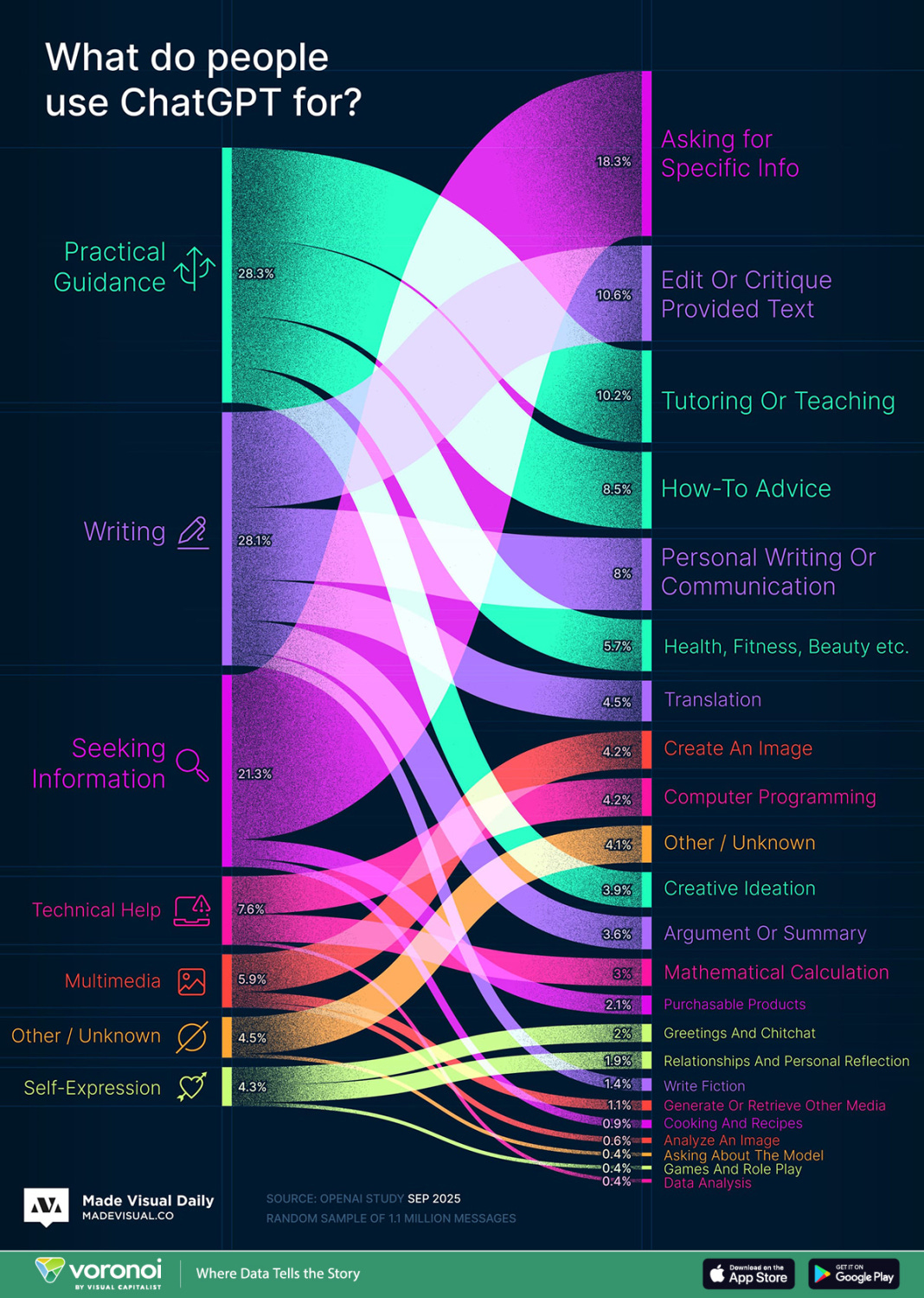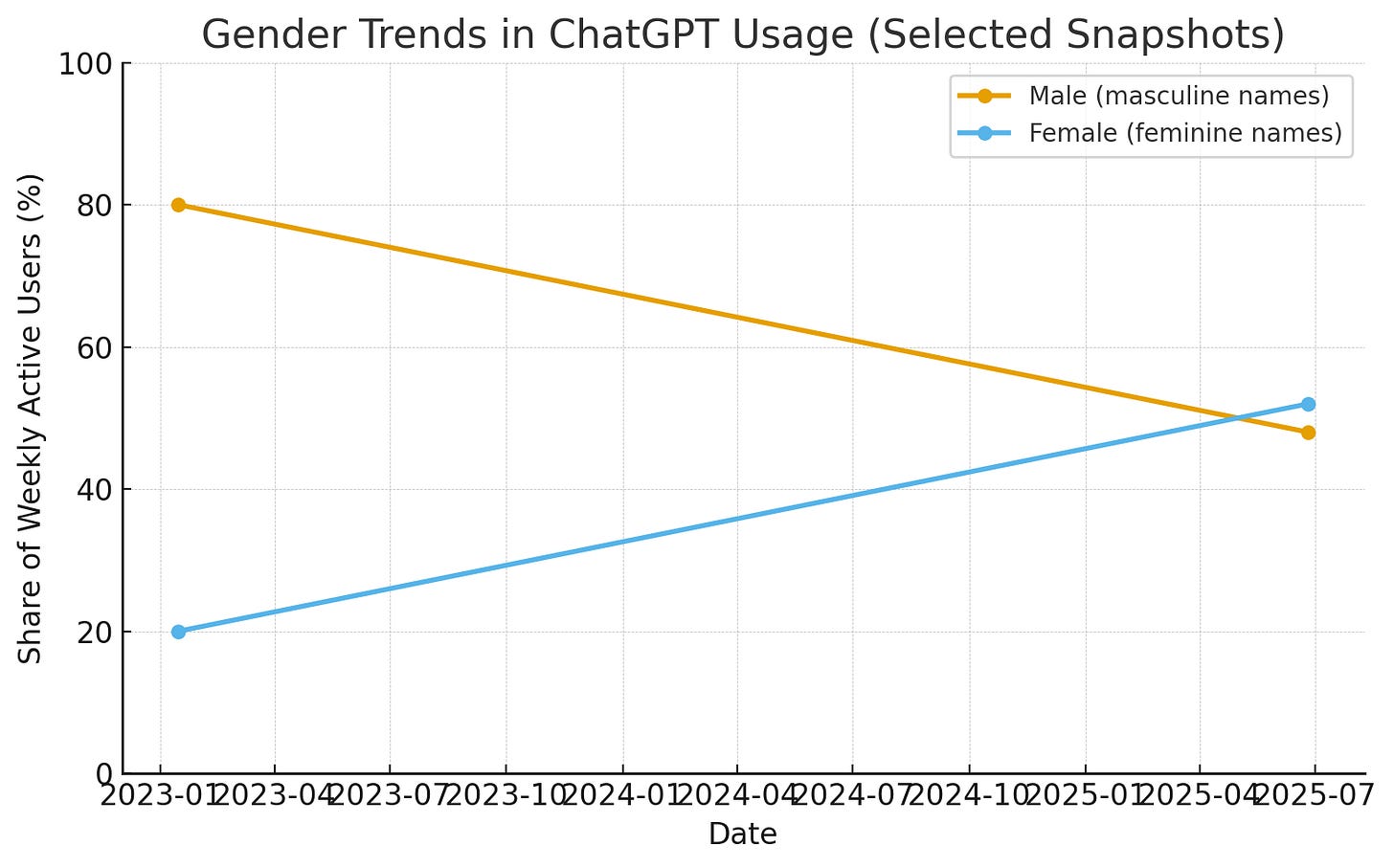As an AI and technology leader, I’ve witnessed firsthand how generative AI has transformed how people work, learn, and create. The newly released OpenAI study, “How People Use ChatGPT” (September 2025), offers the first large-scale, privacy-preserving analysis of how millions of people worldwide are actually using ChatGPT. The results reveal fascinating shifts in human–AI interaction — with implications far beyond productivity alone.
This study analyzed over 18 billion weekly messages sent by 700 million users, representing nearly 10% of the global adult population. What it uncovers about ChatGPT usage trends in 2025 paints a vivid picture of AI adoption at scale — from the boardroom to the classroom, and from Silicon Valley to emerging markets.The Rise of Everyday AI
When ChatGPT launched in late 2022, its meteoric rise broke every record for technology diffusion. By mid-2025, usage had become mainstream: 700 million weekly users sending billions of messages every day. But what are people doing with all those prompts?
The study finds that non-work use has grown faster than work-related use, rising from 53% in mid-2024 to more than 70% of all ChatGPT messages in 2025. While professionals have integrated AI into their workflows, ordinary users are increasingly turning to ChatGPT for learning, creativity, and personal productivity.
This democratization of AI mirrors the early internet era — where technology’s value expanded exponentially once it reached homes, schools, and small businesses.
How the World Uses ChatGPT
The research classifies conversations into seven broad categories, revealing that three of them dominate global usage:
Practical Guidance — everyday advice, tutoring, and creative ideation
Seeking Information — fact-finding and research queries
Writing — drafting, editing, summarizing, and translation tasks
Together, these account for nearly 80% of all ChatGPT conversations.
Interestingly, writing tasks dominate at work, making up 40% of work-related messages. But most of this isn’t from scratch — two-thirds of writing interactions involve editing, critiquing, or improving user text, showing that users are co-creating with AI, not replacing their own voice.
By contrast, computer programming accounts for just 4.2% of total messages, despite its prominence in AI discourse. The majority of users are writers, learners, professionals, and creators — not coders.
AI at Work: Asking vs. Doing
A particularly insightful framework introduced in the paper classifies AI interactions as Asking, Doing, or Expressing:
Asking (49%) — seeking information or advice to make better decisions
Doing (40%) — having the AI perform a concrete task or create content
Expressing (11%) — sharing thoughts, emotions, or reflections
For workplace use, Doing tasks (like writing, reporting, and data handling) make up over 56% of messages, underscoring ChatGPT’s role as a co-pilot for execution. But the fastest growth area is Asking — signaling that people increasingly rely on AI for decision support and strategic thinking.
In other words, AI isn’t just a tool to do work faster; it’s becoming a partner in how we think and decide.
Economic Impact and Global Adoption
The economic implications are profound. The study estimates that ChatGPT provides measurable value through decision support, particularly in knowledge-intensive roles. As knowledge workers use AI to refine judgment and communication, productivity and cognitive reach expand — not by automation, but by amplification.
Some standout trends:
AI adoption has surged in lower- and middle-income countries, showing the globalization of digital intelligence.
The gender gap has closed: early adopters were 80% male, but by 2025 women slightly outnumber men among active users.
Nearly half of all ChatGPT users are under 26, indicating that Gen Z is leading the shift toward AI-augmented living.
Educated professionals use ChatGPT more often for work, especially for writing, analysis, and creative problem-solving, while younger and newer users lean toward learning and practical guidance.
The New Language of Work
One of the most striking findings is how similar the use of ChatGPT is across different professions. Whether in business, engineering, education, or healthcare, users gravitate toward the same types of activities:
Getting and interpreting information
Making decisions and solving problems
Documenting and communicating results
This convergence suggests that AI is reshaping the universal language of knowledge work — centered on information, creativity, and communication.
Generative AI’s unique capability to produce text, code, and visuals in natural language is dissolving boundaries between technical and non-technical domains. It’s not just changing what we do — it’s changing how we do it.
Privacy and Trust at Scale
Crucially, the study also showcases a pioneering privacy-preserving research model. No human researchers viewed user messages; instead, automated classifiers and data clean rooms ensured anonymity. This approach sets a new standard for ethical AI research — proving that meaningful insights and user privacy can coexist.
What This Means for AI Leaders
From an AI leadership perspective, three lessons stand out:
AI adoption is personal. The biggest growth is in everyday, non-work use. This shows that to drive adoption, AI must solve real human problems, not just corporate ones.
Decision support is the killer app. The most valuable use of AI lies in improving how people think, not just how fast they work.
Equity is the new frontier. With rapid uptake in developing economies and among younger users, AI’s global impact will depend on access, education, and trust.
The Future of Human–AI Collaboration
The ChatGPT Usage Trends 2025 study confirms what many of us in AI leadership already sensed: generative AI is moving from hype to habit. It’s no longer a futuristic tool — it’s becoming a daily partner in thought and creation.
The future of AI adoption won’t be defined by who builds the most powerful models, but by who builds the most empowering experiences. And that means understanding people — how they ask, how they learn, and how they create — at scale.
As we look to 2026 and beyond, the challenge for AI leaders isn’t just to accelerate adoption, but to shape it responsibly — ensuring that AI enhances human potential everywhere it’s used.




